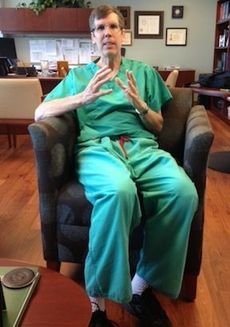
Jim Fair
Mary Mabry explains the CyberKnife, a robotic radiosurgery system, and the most advanced technological tool available to treat tumors.

Jim Fair
". . . it's so precise, laser guided, that you can treat a tumor half the size of a dime and destroy it with radiation and not have any scars."
Dr. Timothy Yeatman
President of the Gibbs Cancer Center & Research Institute

Patients are able to breathe normally and relax comfortably during treatment. It does not require rigid, uncomfortable frames to keep patients in place.
This painless and noninvasive system has laser-guided precision that can destroy tumors without invasive surgery in the spine, brain, prostate, lung and liver. See videos here.
“We’re developing, at the Pelham area, centers of excellence, said Dr. Timothy Yeatman, director of the Gibbs Cancer Center and president of the Gibbs Cancer Center & Research Institute. It will be a center of excellence for radiosurgery.
“If you need to get radiosurgery, it’s so precise, laser guided, that you can treat a tumor half the size of a dime and destroy it with radiation and not have any scars. I call it scarless surgery,” Yeatman said.
A $2.2 million building expansion will house Pelham’s second accelerator.
A model of the CyberKnife was at the Pelham Medical Center’s station at the Family Fest. “It allows treatment for tumors at any angle,” said Mary Mabry, Director of the Bearden-Josey Center for Breast Health.
Mabry exhibited the flexible robotic arm that has specialized tracking capabilities to reach body regions that significantly lowers the amount of radiation delivered to surrounding tissue.
Patients are able to breathe normally and relax comfortably during treatment. It does not require rigid, uncomfortable frames to keep patients in place.
A benefit is the ability for the CyberKnife to track and automatically correct for tumor motion during treatment. Vests with sensors are worn during the treatment that allows for respiratory patterns to be tracked to ensure high doses of radiation are pinpoint accurate.
Jack Murrin, a member of the Pelham Medical Board and CFO at Greenville-Spartanburg International Airport, was at a presentation two weeks ago. “I couldn’t believe it accounted for (natural) movement. It’s extremely exciting and revolutionary,” Murrin said.
Stanford invented the CyberKnife in 1994. More than 600,000 patients have been treated by almost 600 systems in 33 countries.
There is no overnight stay in a hospital as CyberKnife treatment lasts 30-90 minutes.
The course of the treatment is five treatments or less and appointments can be scheduled at the patient’s convenience so there is minimal loss of time away from family or job, according to the Stanford Hospital web site.
“Technology changes so fast. If you’re stuck with 20-year old technology you’re going to get 20-year old therapy,” Yeatman said. “What we’ve done is upgrade the technology here to the very latest cutting edge technology.”
“With the CyberKnife you are shooting a tiny beam in every access point of the tumor so that any one piece of tissue that gets hit with that little beam doesn’t get hurt,” Yeatman said.
Yeatman said the best way to visualize the CyberKnife is to understand how a magnifying glass pinpoints the flashpoint of fire on a piece of paper. But there is no burn “tissue” during treatment.
“It’s laser guided, with precise focus of the radio therapy and gives the patient much lower toxicity. It’s much more defined therapy and preserves the normal tissue,” Yeatman said.